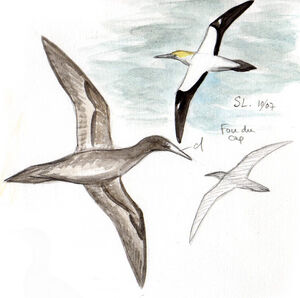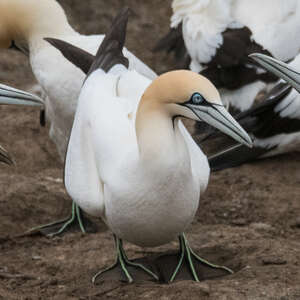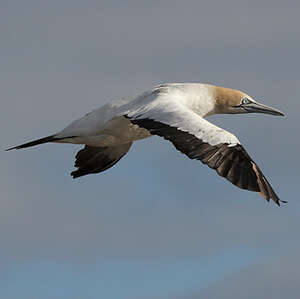Cape Gannet
Morus capensis - Fou du Cap
Identification
This is the Cape Gannet, a large black and white (adults), brown (juveniles) or patterned black, white and brown (immatures) seabird. Adults have an orange head and a greyish beak. It can be mistaken for the Northern Gannet (Morus bassanus), which can be distinguished by the secondary remiges (large feathers at the back of the wing) and the black rather than white rectrices. The differences with the Australasian Gannet (Morus serrator) are much more subtle, with the Australasian Gannet having a shorter, descending black line from the beak to the throat, and the outer rectrices being white.
Subspecific information monotypic species
Foreign names
- Fou du Cap,
- Alcatraz de El Cabo,
- alcatraz-do-cabo,
- Kaptölpel,
- fokföldi szula,
- Kaapse Jan-van-gent,
- Sula del Capo,
- kapsula,
- Kappsule,
- sula tmavochvostá,
- terej jihoafrický,
- Kapsule,
- kapinsuula,
- Witmalgas,
- mascarell del Cap,
- Höfðasúla,
- głuptak przylądkowy,
- Kāpzemes sulla,
- kapski strmoglavec,
- Капская олуша,
- ケープシロカツオドリ,
- 南非鲣鸟,
- kapsula,
- 南非鰹鳥,
Voice song and call
Habitat
Behaviour character trait
The Cape Gannet is very social on breeding sites and adults are rarely seen straying far from these sites. The juveniles disperse as far as the Gulf of Guinea on the Atlantic coast and Mozambique on the Indian coast, with some even being observed in Australia. It is very rare to see them on the coasts of Europe (Portugal and Spain) and it has never been seen in France.
Flight
Reproduction nesting
Compact colonies established on mostly flat islands. The global population is distributed over only 6 islands. The nest is made up of debris collected from the sea and agglomerated by the droppings of the birds. Lays only one egg which is incubated for a month and a half. The chicks take flight after more than 3 months. Adults at 3 or 4 years old.
Threats - protection
IUCN conservation status
concern
in the Wild
threatened
evaluated
The population ranges from 80,000 to 100,000 couples. After a severe decline, it is now slowly increasing. Long hunted for human consumption (which is no longer the case), it has suffered severe disturbance due to guano exploitation. Overfishing, which leads to a sharp decrease in prey, is also a problem that could prove to be crucial in the coming years. The main predator is the Cape Fur Seal (Arctocephalus pusillus), which captures young birds in colonies, sometimes leading to their abandonment.
Sources of information
- IOC World Bird List (v15.1), Gill, F and D Donsker (Eds). 2025-12-07.
Other sources of interest
 Specification sheet created on
29/07/2023 by Georges Olioso
Specification sheet created on
29/07/2023 by Georges OliosoTranslation by AI Oiseaux.net
© 1996-2025 Oiseaux.net
- Accipitriformes
- Aegotheliformes
- Anseriformes
- Apodiformes
- Apterygiformes
- Bucerotiformes
- Caprimulgiformes
- Cariamiformes
- Casuariiformes
- Charadriiformes
- Ciconiiformes
- Coliiformes
- Columbiformes
- Coraciiformes
- Cuculiformes
- Eurypygiformes
- Falconiformes
- Galliformes
- Gaviiformes
- Gruiformes
- Leptosomiformes
- Mesitornithiformes
- Musophagiformes
- Nyctibiiformes
- Opisthocomiformes
- Otidiformes
- Passeriformes
- Pelecaniformes
- Phaethontiformes
- Phoenicopteriformes
- Piciformes
- Podargiformes
- Podicipediformes
- Procellariiformes
- Psittaciformes
- Pterocliformes
- Rheiformes
- Sphenisciformes
- Steatornithiformes
- Strigiformes
- Struthioniformes
- Suliformes
- Tinamiformes
- Trogoniformes
























